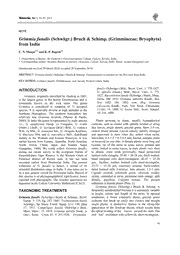
Grimmia funalis (Schwägr.) Bruch & Schimp. (Grimmiaceae; Bryophyta) from India PDF
Preview Grimmia funalis (Schwägr.) Bruch & Schimp. (Grimmiaceae; Bryophyta) from India
Taiwania, 56(1): 81-83, 2011 NOTE Grimmia funalis (Schwägr.) Bruch & Schimp. (Grimmiaceae; Bryophyta) from India C. N. Manju(1*) and K. P. Rajesh(1) 1. Department of Botany, the Zamorin’s Guruvayurappan College, Calicut, Kerala, India. * Corresponding author. Malabar Botanical Garden, Olavanna, Calicut, Kerala, India. Email: [email protected] (Manuscript received 29 March 2010; accepted 28 September 2010) ABSTRACT: Grimmia funalis (Schwägr.) Bruch & Schimp. (Grimmiaceae) is reported for the first time from India. KEY WORDS: Grimmia funalis, Grimmiaceae, new record, Western Ghats, India. funalis (Schwägr.) Brid., Bryol. Univ. 1: 770.1827. INTRODUCTION D. spiralis (Hook.) Brid., Bryol. Univ. 1: 771. Grimmia, originally described by Hedwig in 1801, 1827. Racomitrium funale (Schwägr.) Hueb., Musc. is the largest genus in the family Grimmiaceae and is Germ. 200. 1833. Grimmia imberbis Kindb., Bot. commonly known as dry rock moss. The genus Not. 1882: 186. 1882. nom. illeg. Grimmia Grimmia is considered to comprise of 71 accepted calvescens Kindb., Forh. Vid. Selsk. Christiania, species. It is especially diverse at high altitudes in the 111(6): 19. 1888. G. hornii Stirt., Scott. Natural. Northern Hemisphere. The southern hemisphere has 10: 218. 1890. relatively low Grimmia diversity (Munoz & Pando, 2000). In India the genus is represented by eight species Plants growing in dense, usually hemispherical viz., G. apophysata Hamp. ex Gangulee, G. ovalis cushions, seen as cluster with spirally twisted or string (Hedw.) Lindb., G. laevigata (Brid.) Brid., G. redunca like leaves; single shoots, greyish green. Stem 2-5 cm, Wils. ex Mitt., G. donniana Sm., G. elongata Kaulfuss, central strand present. Leaves usually spirally arranged G. khasiana Mitt. and G. macrotheca Mitt., distributed and appressed to stem when dry, patent when moist, mainly in the Western and Eastern Himalyas. It was lanceolate, 0.5-1.5 × 0.2-0.5 mm, keeled, margins plane earlier known from Europe, Australia, North America, or recurved on one side, in female plants awns long and North Africa, China, Japan and Eastern Nepal hyaline, tip of the awns in some leaves pointed and (Gangulee, 1969). We could collect Grimmia funalis, entire, forked in some leaves, in male plants very short during our recent survey in the evergreen forests of to absent, costa weak proximally; basal juxtacostal Parambikulam Tiger Reserve in the Western Ghats of laminal cells elongate, 55-60 × 20-28 µm, thick-walled; Palakkad district of Kerala state. It has not been basal marginal cells short-rectangular, 40-45 × 22-28 recorded earlier from Peninsular India. The present µm, hyaline; median laminal cells short-rectangular, collection of G. funalis is hence, a record of its 25-35 × 15-20 µm, extremely sinuose, thick-walled; extended distribution range to India. It also turns out to distal laminal cells 2-stratose. Seta arcuate, 1.5-2 mm. be a new generic record for Peninsular India. Record of Capsule exerted, yellowish green, obovoid, weakly this species is of phytogeographical significance, hence striate, concealed in awns, peristome teeth orange, split reported with photographs. The voucher specimens are distally, papillose. Calyptra mitrate. The present deposited in the Calicut University Herbarium (CALI). collection is female plants (Plate 1). Grimmia funalis (Schwägr.) Bruch & Schimp. is TAXONOMIC TREATMENTS frequently misidentified because it is extremely variable in height, colour, and length of the awns. In optimal Grimmia funalis (Schwägr.) Bruch & Schimp., Bryol. conditions, it forms extremely dense, greyish green Europ. 3: 119, fig. 247. 1845. Trichostomum funale cushions that break up easily into clusters and straight Schwägr., Sp. Musc. Frond. Suppl. 1(1): 150, plate single plants. A distinctive feature is the string-like 37. 1811. Campylopus funalis (Schwägr.) Brid., appearance of the dried-up shoots, which results from Mant. Musc.: 75. 1819. Grimmia spiralis Hook. in the spiral twisting of the leaves around the stem. The Grev., Scott. Crypt. Fl., 4: 203.1826. Dryptodon mid leaf areolation with yellowish, short-rectangular, 81 Taiwania Vol. 56, No. 1 Plate 1. A: Habit of Grimmia funalis. B: Leaf. C: Dome shaped leaf tip. D: Forked leaf tip. E: Basal maginal hyaline cells. F: Juxtacostal laminal cells. G: Median cells. 82 March, 2011 Manju & Rajesh: Grimmia funalis from India very thick, and sinuose cell walls is characteristic. The Australia. Gangulee (1969) reported this species from formerly recognized taxa such as G. calvescens Kindb., Eastern Nepal not from Indian region. G. imberbis Lindb. ex H. Moller, and G. ryanii Limp. are actually male plants of G. funalis (Munoz & Pando, 2000). They grow in separate cushions with muticous to ACKNOWLEDGEMENTS short-awned leaves, deviating greatly from the much taller, long-awned female plants. These male plants The first author is thankful to the Department of Science might be confused with G. elongate Kaulf., which and Technology (DST), New Delhi for the award of Young frequently grows in the same habitat, or with G. Scientist Fellowship. We are also thankful to the staff caespiticia (Bridel) Juratzka. However, in G. elongata members of the Kerala Forest Department of the Parambikulam Tiger Reserve for extending support during the Kaulf. the basal cells are pellucid, straight, and field study. thin-walled or only slightly incrassate. In G. caespiticia (Bridel) Juratzka. the basal cells are shorter, tending to be quadrate to short-rectangular, and the leaf apex is LITERATURE CITED cucullate (Munoz & Pando, 2000). Munoz, J. and F. Pando. 2000. A world synopsis of the Specimen examined: On rocky patches in grassland. India, genus Grimmia. Monographs in Systematic Botany from Kerala, Palakkad district, Parambikulam Tiger Reserve (1400 m) the Missouri Botanical Garden, 83: 133. MCN 106826 (CALI). Gangulee, H. C. 1969. Mosses of Eastern India and adjacent Distribution: It is distributed in Nepal, China, regions. Vol. I. Botanical Survey of India, Calcutta, India. Japan, Europe, North Africa, North America and 830pp. 印度的乾岩紫萼苔 C. N. Manju(1*) and K. P. Rajesh(1) 1. Department of Botany, the Zamorin’s Guruvayurappan College, Calicut, Kerala, India. * 通信作者。Malabar Botanical Garden, Olavanna, Calicut, Kerala, India. Email: [email protected] (收稿日期:2010年3月29日;接受日期:2010年9月28日) 摘要:本文首次報導印度的新紀錄種-乾岩紫萼苔 (Grimmia funalis (Schwägr.) Bruch & Schimp.)。 關鍵詞:乾岩紫萼苔、紫萼苔科、新紀錄種、西高止山、印度。 83
